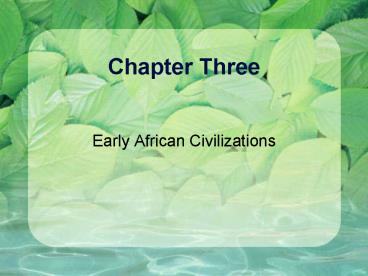Chapter Three - PowerPoint PPT Presentation
1 / 21
Title:
Chapter Three
Description:
By late centuries BCE all of Africa except densely forested areas and deserts ... Most exalted deity. Amon: Deity of Thebes (administrative center of Upper Egypt) ... – PowerPoint PPT presentation
Number of Views:53
Avg rating:3.0/5.0
Title: Chapter Three
1
Chapter Three
- Early African Civilizations
2
Transitions
- Hunter-gatherer groups
- Agricultural villages
- Small states
- Large complex societies
3
Agriculture
- Began in Sudan (between Sahara and tropical rain
forest) - Spread to Nile River Valley
- By late centuries BCE all of Africa except
densely forested areas and deserts were
practicing agriculture.
4
Sudan area
- After 5000 BCE we see
- Small kingdoms
- Divine or semi-divine monarchs
- Based on agriculture and herding
5
Early Religion of Sudan
- Concepts of the sacred
- Different spirits who were forms of one spirit.
- The one spirit was impersonal, causing good and
evil, associated with rain. - Forms included sun, wind, rain, trees, rivers,
and other natural forces. - Monarch was divine or semi-divine
6
Belief in afterlife
- Upon death of the king, servants were killed and
buried with him in order to serve him in the
afterlife.
7
Buntu Speaking Peoples
- Original homeland in the Niger-Congo area around
4000 BCE - Semi-nomadic cultivators and herders
- Migrated south and southwest.
- By 1000 BCE Bantu people and languages spread
throughout sub-Saharan Africa.
8
Societies before 1000 CE
- Stateless societies
- Governed themselves through family and kinship
group - Villages of about 100
- Male heads of family constituted village council
- Chiefs represented the village to neighboring
villages - A group of villages constituted a district.
- No chief or governor for the district.
- Individual villages and families disciplined
their own.
9
Early Religion
- Conception of the Sacred
- Nyamba Creator who established natural and moral
order. - Ancestors
- Territorial spirits
10
Ritual Life
- Ceremonies to mark stages of life birth,
puberty, marriage, death. - Prayers to ancestors and spirits
- Sacrifices
11
Ritual specialists
- Called upon to explain why problems arose in the
society and to offer remedies.
12
Compare Sudanic and Bantu religions
- Can you see any relation between religious
beliefs and practices and the structure of the
society? - How do different conceptions of the sacred
correspond to social realities? - Can you offer a theory of why both societies were
monotheistic?
13
Egypt and Nubia
- After 4000 BCE small kingdoms arise in Nubia and
southern Egypt. - By 3300 BCE small kingdoms throughout Egypt and
Nubia - Competition for resources led to conflict.
- Though Nubia had a period of expansion, Egypt
became stronger power. Why?
14
Egypt
- Rulers of different Egyptian kingdoms united
around 3100 BCE. - Centralized state ruled by a pharaoh.
- Pharaohs most powerful during first period of
Egyptian history
15
Periods of Egyptian
- Archaic period 3100-2600 BCE
- Old Kingdom (2660-2160 BCE)Pyramids
- Period of decline of Pharoahs power and rise of
regional powers (2160-2040 BCE) - Middle Kingdom (2040-1640 BCE) ended with
invasion of nomadic Hyksos from Southwest Asia. - New Kingdom (1550-1070 BCE) in the Nile Delta.
Expelled Hyksos.
16
New Kingdom (1550-1070 BCE)
- Prosperous
- Perhaps 4 million people
- Well organized bureaucracy.
- Pharaohs did not build pyramids, but temples and
monuments. - Imperial expansion into Nubia and southwest Asia
met with a backlash. - Mid seventh century BCE Assyria conquered Egypt.
17
Social structure
- Pharaoh supreme ruler
- Priests
- No inherited nobility as in Mesopotamia but
possibility of rise in status possible. - Professional class military and administrative
- Commoners crafts, trade, agriculture
- Peasants
- Slaves
18
Divine kingship
- Early pharaohs claimed to be deities.
- At death servants entombed with them.
- The notion is believed to have come from Sudanic
peoples who migrated to Egypt. - Absolute rulers possessing of the land.
19
Lords of the heavens
- Early pharaohs associated with Horus, the sky
deity. - Later pharaohs associated with Amon, the sun
deity. - Regarded as sons of the sun.
- As (father) sun supervised wider cosmos, pharaoh
(son) attended to the earth. - After death the pharaoh was believed to merge
with the Amon.
20
Most exalted deity
- Amon Deity of Thebes (administrative center of
Upper Egypt) - Re Deity of Heliopolis
- Amon-Re Two gods merged
- Most believed that Amon-Re was one god among many
in the world, but the idea emerged that Amon-Re
was a universal deity. - Aten Worshipped as one and only god.
21
Other Deities
- Osiris Lord of the afterlife, judge of the dead.
- Hapi the Nile
- Many others































